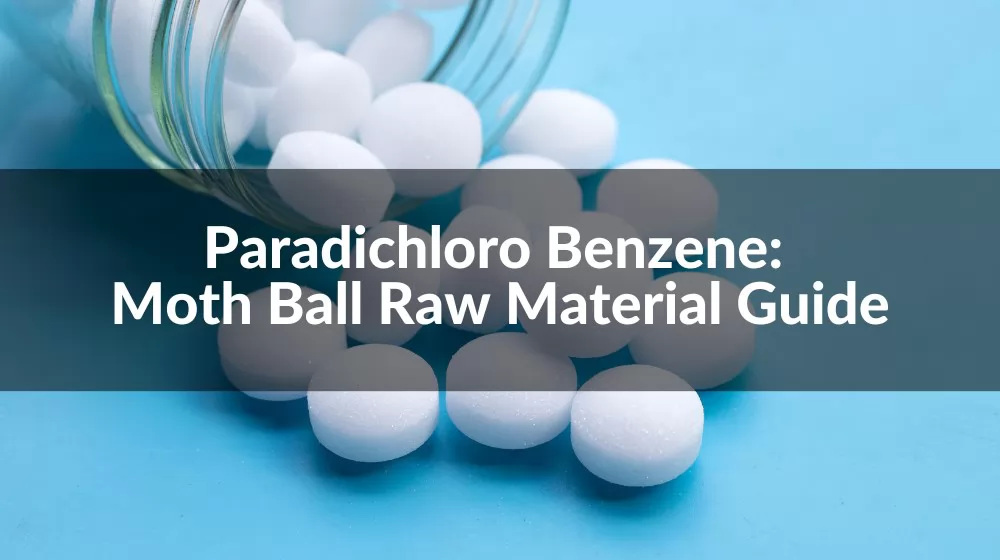

Welcome to the comprehensive guide on Paradichlorobenzene. This essential read delves into the intricacies of Paradichlorobenzene (PDCB), the cornerstone component in mothball production. From its molecular structure to its pivotal role in manufacturing mothballs, this article unveils everything you need to know about this key raw material. Perfect for manufacturers and consumers alike, our guide provides a detailed exploration of PDCB’s properties, uses, and safe handling practices.
When we talk about Paradichlorobenzene, a key ingredient in mothball production, we're delving into a world where chemistry meets everyday utility. Paradichlorobenzene, often abbreviated as PDB, is an organic compound that is crucial in the manufacturing of mothballs, a common household item used for protecting fabrics from moths and other pests.
The molecular structure of Paradichlorobenzene is relatively simple yet fascinating. It consists of a benzene ring, which is a hexagonal arrangement of carbon atoms, with two chlorine atoms attached to it. These chlorine atoms are positioned opposite each other on the ring, which is where the term 'para' in its name comes from. This specific arrangement not only defines its chemical properties but also its effectiveness as a moth repellent.
In terms of its physical properties, Paradichlorobenzene is a white, crystalline solid at room temperature, with a distinct, somewhat aromatic odor. It's this characteristic odor that is key in mothball applications, as it's effective in repelling moths and other insects.
The simplicity of this molecule belies its efficacy. In the realm of mothball manufacturing, the structure of Paradichlorobenzene plays a pivotal role. Its stability, low reactivity, and volatility at room temperature make it an ideal candidate for use in mothballs. It sublimates, meaning it transitions from a solid to a gas without becoming a liquid, a property that allows for the slow release of the compound, providing long-term protection for stored fabrics.
Paradichlorobenzene, a key player in mothball manufacturing, boasts unique physical properties that make it particularly effective. It appears as a white, crystalline solid under normal conditions. One of its most notable characteristics is its distinctive odor, often associated with the smell of mothballs. This odor is a natural deterrent for moths and other fabric pests.
A significant physical property of Paradichlorobenzene is its volatility. It has a relatively low melting point of about 53°C (127°F) and a boiling point of 174°C (345°F). This allows it to sublimate, transitioning directly from a solid to a gas at room temperature. This sublimation is crucial in mothball applications, as it enables a gradual release of the compound, providing long-lasting protection without leaving a liquid residue.
Furthermore, its solubility in water is quite low, but it is soluble in organic solvents like alcohol, ether, and benzene. This solubility profile is essential in certain industrial applications where Paradichlorobenzene is used as an additive or a processing aid.
Moving to the chemical realm, Paradichlorobenzene is an aromatic hydrocarbon, classified as a chlorinated derivative of benzene. Its chemical formula is C6H4Cl2. The presence of two chlorine atoms attached to the benzene ring at opposite ends (para position) significantly influences its reactivity.
Paradichlorobenzene is relatively stable and non-reactive under normal conditions. This stability is a boon in its storage and handling, reducing risks associated with reactive chemicals. However, when exposed to high temperatures or in the presence of strong oxidizing agents, it can undergo various chemical reactions.
It's also worth noting that Paradichlorobenzene can participate in halogenation reactions, where more chlorine atoms can be added to the molecule. These reactions, though not typically utilized in mothball applications, are important in the synthesis of other chemical compounds.
The manufacturing process of Paradichlorobenzene begins with the extraction and refinement of this vital compound. Typically, it is produced through a process of chlorination of benzene, where chlorine gas is reacted with benzene in the presence of a catalyst, such as ferric chloride. This reaction leads to the formation of Paradichlorobenzene, among other byproducts.
Following the initial reaction, the next critical step is the purification of Paradichlorobenzene. This is typically achieved through a series of distillation processes. The raw product, which may contain a mixture of different chlorinated benzene compounds, is carefully refined to isolate Paradichlorobenzene in a high-purity form. This step is crucial as the purity of Paradichlorobenzene greatly affects its efficacy and safety in mothball production.
Quality control and adherence to safety standards are paramount in the manufacturing process of Paradichlorobenzene. Given its application in household products, ensuring the highest purity and safety standards is non-negotiable. Manufacturers employ various analytical methods, such as gas chromatography, to assess the purity and composition of the final product.
Safety in the production process is also a major concern. Paradichlorobenzene, while relatively stable, can pose health and environmental risks if not handled correctly. Manufacturers must adhere to strict safety protocols, including the use of protective gear, proper ventilation systems, and adherence to environmental regulations regarding emissions and waste disposal.
Regular audits and inspections are part of the production routine to ensure compliance with international safety standards and regulations. This not only safeguards the workers involved in the production process but also ensures that the final product meets the required safety standards for consumer use.
The most well-known and widespread use of Paradichlorobenzene is in the production of mothballs. These small, solid balls are a staple in many households, used for their effectiveness in repelling moths and other fabric pests. The strong odor of Paradichlorobenzene, which is both distinctive and effective, plays a crucial role in this application. It not only repels pests but also masks the scent of fabrics, making them less attractive to moths.
The ability of Paradichlorobenzene to sublimate at room temperature is particularly advantageous in mothball production. This property allows for a controlled release of the compound over time, ensuring long-term protection of clothing, linens, and other fabric items stored in closets, drawers, or storage boxes.
Beyond mothballs, Paradichlorobenzene finds its use in a variety of other industrial and commercial applications. Due to its chemical properties, it is used as a precursor in the synthesis of other chemicals. For instance, it serves as a starting material in the production of certain dyes, pharmaceuticals, and agricultural products.
In the realm of industrial applications, Paradichlorobenzene is sometimes used as a deodorizer or for odor control, especially in situations where its strong scent can mask unpleasant odors. Additionally, its volatility makes it useful in certain settings as an insecticide, particularly in scenarios where long-term pest control is needed.
Paradichlorobenzene's role in these various applications highlights its versatility. Whether it's in protecting cherished garments from pests or playing a part in the synthesis of complex chemical products, its impact is significant and multifaceted.
In conclusion, Paradichlorobenzene’s role in the production of mothballs and its diverse applications in various industries cannot be overstated. Understanding its properties, manufacturing processes, and safety considerations is crucial for manufacturers and consumers alike. For those seeking a reliable and leading source of Raw Material for Mothball, HighMountain Chem stands out as a premier PDCB manufacturer. Discover more about their high-quality products and commitment to excellence at www.highmountainco.com.
The main risks associated with Paradichlorobenzene exposure include respiratory irritation, central nervous system effects like dizziness and headaches, and potential impacts on liver and kidney function with prolonged exposure. It's also classified as a possible human carcinogen, necessitating careful handling and use.
Yes, there are eco-friendly alternatives to Paradichlorobenzene for moth prevention, such as cedar wood, lavender, and non-toxic moth traps. These alternatives are increasingly popular due to environmental and health concerns associated with chemical repellents.
Over the years, the Paradichlorobenzene industry has evolved with advancements in manufacturing processes, increased regulatory oversight, and growing environmental consciousness. This evolution has led to improved safety standards, more efficient production methods, and exploration of sustainable alternatives.
Common misconceptions include the belief that mothballs are completely safe for household use without precautions, and that all mothballs contain Paradichlorobenzene. Some people also underestimate the potential health risks associated with improper use. It's important to recognize the need for safe handling and to be aware of the different active ingredients used in mothballs.









